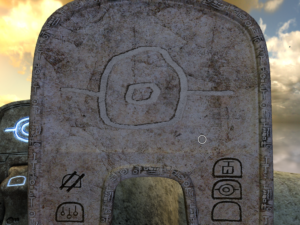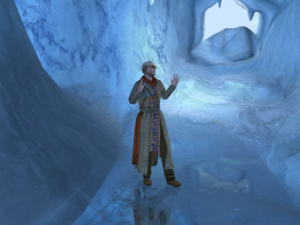Myst V: Defending 3D
I’m well into the fourth subworld now. (The “ages” all have names, but I don’t know them. Esher only mentions them once.) This bit must be more graphically complex than the ones preceding it, because the framerate is getting choppy again. It’s nowhere near as bad as it was when I was using faulty hardware, but it’s bothersome enough that I’ve searched online for help again. In the process, I found reviews like this one and these. I had been avoiding reviews up to now, for fear of spoilers, but now that I’m almost done, there seemed less harm in reading them.
Having done so, I feel like I’m losing some cred by not hating Myst V. Sure, I’ve complained about the drawing interface, but that’s a fairly superficial matter. And yeah, it’s not Riven, but neither were Mysts 3 and 4.
Rasmussen, in contrast, objects at length and in detail to the fact that it’s done in a 3D engine at all. I have to disagree. The ability to move freely is a very big deal. It ends the frustration of limited views: countless times in Myst and Myst-likes, I’ve wanted to get a closer view of something, or look at it from a different angle, but been denied. More importantly, the traditional Myst-like interface makes navigation depend on noticing hotspots. Every time you enter a new area in such a game, you pretty much have to wave your mouse around to find all the places you’re allowed to step. Missing even one can effectively lock you out of crucial areas of the game (as happened to me in a couple of spots in Myst IV). This is not realistic and it is not good gameplay. There’s still a certain amount of hotspot-hunting in a 3D game — there are still things you have to click on to operate, after all. But the buttons on a machine tend to be more obvious than the exitable portions of a grassy wilderness.
I understand that a lot of Myst fans were apprehensive about the shift to 3D. It makes sense to be apprehensive when you think about other series that also decided to shift to 3D for their final episodes, such as Ultima and King’s Quest. But those games are mainly the result of the developers devoting so much effort to figuring out the new technology that they couldn’t devote adequate attention to the content. Thanks to RealMyst and Uru, Cyan already had their first experimental fumblings behind them.
 Comments(3)
Comments(3)

